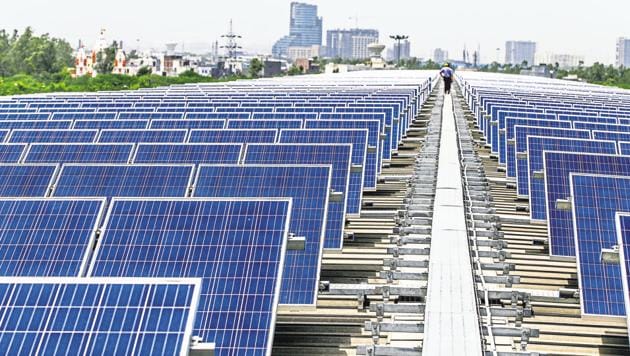The electricity system of the future will be more decentralised
The inertia in the legacy electricity system persists due to regulatory barriers. For instance, time-of-day electricity pricing (currently absent) could nudge consumers to use appliances in off-peak hours. This would make it more feasible for distributed renewables to supply customers without needing additional storage.
In Dwarka, New Delhi, more than a dozen housing societies have benefited from Solarise Dwarka, a programme to supply power for common areas with distributed solar installations. With 2.5 megawatts already installed, the utility (BSES Rajdhani) has received further orders for 6.5 MW. In Chhattisgarh, more than 1,000 health centres are using rooftop solar systems, saving on diesel costs and improving health outcomes (emergency services, outpatient services, pregnant women choosing to deliver children in the PHCs).

The electricity system of the future will look different from the past. Will utilities and power transmission companies passively witness the systemic disruption?
Several disruptions — in technology and business models — are occurring concurrently. First, generating power from distributed renewable energy (DRE) reduces demand on the grid. Instead of a single centralised system, technology allows for potentially millions of points of generation.
Meanwhile, global demand for stationary electricity storage, excluding pumped hydro, could rise from 400 megawatt-hour in 2015 to 50 gigawatt-hour by 2025. By flattening electricity demand curves for low- and high-demand periods, distributed storage reduces the need for peak power plants supplying into the grid, while increasing the share of renewables.
Another technological development is superefficient appliances. These include household appliances (lights, fans) and wider applications (efficient refrigeration to store vaccines or for milk chilling units). Energy-efficient motors can also power small manufacturing using DRE.
A fourth technological shift is digitalisation. Distributed and real-time optimisation of power production and consumption is possible when digitally connected systems iteratively interact with each other — and coordinate with the network grid. This could also make the power system more resilient with the distributed infrastructure serving as a bulwark against grid emergencies.
Technological disruptions have spawned many DRE business models. If urban households struggled to get easy financing to purchase rooftop solar systems, entrepreneurs have leased systems. The Council on Energy, Environment and Water and BSES Yamuna are planning pilots in east Delhi with innovative financing and billing. Rural areas have pure off-grid solar home systems, leased systems, pay-as-you-consume options, microgrids, community-owned solar irrigation systems, among others.
Yet, DRE remains stunted in India. Centralised power infrastructure continues to be built, without capitalising on grid-interactive distributed renewables.
The inertia in the legacy electricity system persists due to regulatory barriers. For instance, time-of-day electricity pricing (currently absent) could nudge consumers to use appliances in off-peak hours. This would make it more feasible for distributed renewables to supply customers without needing additional storage.
Traditionally, electricity has been treated as a commodity, instead of as a service. Currently, utilities get away with poor-quality service. Imposing strong penalties on utilities for delivering unreliable power would create opportunities for DRE enterprises to plug the gaps. As a service, DRE could support household, community and productive energy needs without needing large infrastructure investments. Further, DRE entrepreneurs could support centralised grid supply, serving as franchisees to provide last mile maintenance services.
Equity and debt finance remains limited. Institutional investors point to regulatory uncertainties and the need for large-sized deals to justify their reluctance to deploy capital into DRE infrastructure. More aggregators are needed to bundle DRE projects. And early-stage innovations need commercial pilots to build a track record of performance to attract investors.
Can consumers pay more for DRE? It is not about affordability. Grid power is cheaper but also unreliable. When consumers place a premium on reliability (hours of supply or stable voltage), they also pay more.
Despite the challenges, some are taking big bets. Engie, one of the world’s largest electricity companies, recently purchased Simpa Energy, a rural rooftop solar firm with operations in Bihar, Odisha and Uttar Pradesh.
Big bets will also face opposition. Electricity is a politically sensitive sector. The power to dispense power is a source of political capital. DRE upends that model, making consumers active participants in managing the electricity system. It is important to develop business models that allow incumbent utilities to find new lines of business and for grid operators to discover strong complementarities with distributed systems.
Equally, consumers will not adopt DRE if they are marketed as second-best alternatives to the grid. When a small rural entrepreneur employs 20 persons in a custom tailoring unit powered by distributed solar, or when the world’s largest motorcycle manufacturer deploys 1 MW rooftop solar for its factory, aspirations shift.
Last weekend, my six-year-old daughter assembled a small solar module to power a make-it-yourself robot that I picked up at the MIT Museum. It’s time to start them young — and prepare them for a future that will look different from the past.
Arunabha Ghosh is CEO, Council on Energy, Environment and Water
The views expressed are personal



